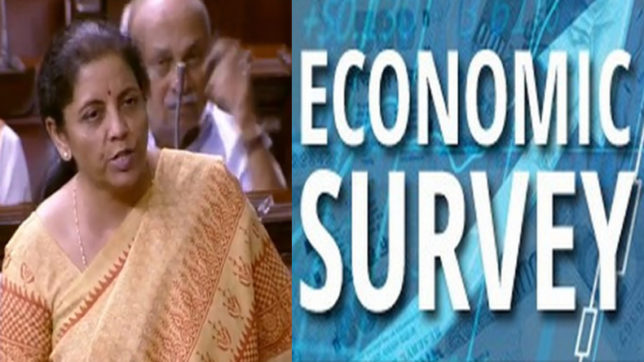The Economic Survey 2018-19 has been tabled in parliament by Finance Minister Nirmala Sitharaman. The Survey has been prepared with inputs from wide range of professionals with newly appointed Chief Economic Advisor Krishnamurthy Subramanian and Principal Economic Advisor Sanjeev Sanyal playing the key role. The Survey predicts the GDP growth for FY 20 at 7 percent compared to 6.8 percent in the previous fiscal year.
The two volume economic Survey provides the roadmap to achieve 5 trillion dollar economy by FY 24 and the second part of the Survey focuses on the picture of ‘state of the economy’. As per the economic survey, the PM Modi’s dream of 5 trillion dollar economy could be achieved if the country grows at 8 percent compound annual growth rate. ‘Investment’ has been pointed out as key to economic growth taking a cue from East Asian economies.
The first volume of Economic Survey, which consists of 11 chapters, has a chapter titled as ‘Ending Matsyanyaya: How to Ramp up Capacity in the Lower Judiciary’ draws attention towards an important issue prevalent in Indian system and that is ‘enforcement of contracts’. The chapter starts with “The Rule of Law and maintenance of order is the science of governance” a quote by Kautilya in his much-celebrated work, Arthashastra.
According to the chapter, in the country, more than 3.5 crore cases are pending in courts. Majority of these cases are in the district and subordinate courts. The chapter further argues that the country is following the law of the jungle or Matsyanyaya (where big fish eats small fish) due to the inefficient court system.

The Ease of Doing Business (EODB) ranking of the country gets hampered due to inefficiency in ‘enforcement of contracts’. India improved its ranking only by one point to reach 163 in enforcement of contracts in the latest report while the overall ranking was 77. As per the Economic Survey, this is ironical for a country that has long idealized contract enforcement. As Tulsi Ramayana puts it,“praan jayi par vachan na jayi” i.e., “one’s promise is worth more than one’s life”.

The Survey further states that the majority (87.54 percent) of the cases are pending in district and subordinate courts. More than 64 percent of the total cases are for more than one year and number of cases (in percentage) pending for more than 10 years is in double digits.

One interesting and much-expected finding is that poorer states have high pendency compared to richer states. The states with the highest pendency are Odisha, Bihar, West Bengal, and Uttar Pradesh. The disposal time which is measured as the time span between the date of filing and the date when the decision is passed is also higher for poorer states like Bihar, Odisha and West Bengal.
According to the Survey, “Simulations of efficiency gains and additional judges needed to clear the backlog in five years” and 100 percent clearance rate (ratio of the number of cases disposed of in a given year to the number of cases instituted in that year) by merely filling out the vacancies in the lower courts and in the High Courts. The Survey also mentions that states of Uttar Pradesh, Bihar, Odisha, and West Bengal need special attention in the enforcement of contracts.
The Survey also argues that the Indian courts could be made more productive by increasing the number of working days, the establishment of Indian Courts and Tribunal Services, and Deployment of Technology.
As India aims to achieve 8 percent compound annual growth rate, it cannot afford to have more than 3.5 crore pending cases. The country cannot afford to have 163 rank in the enforcement of contracts and call itself just and judicious. To become a 5 trillion dollar economy by 2024, the country needs to achieve 100 percent clearance rate and clear the backlog of unproductive years.


































